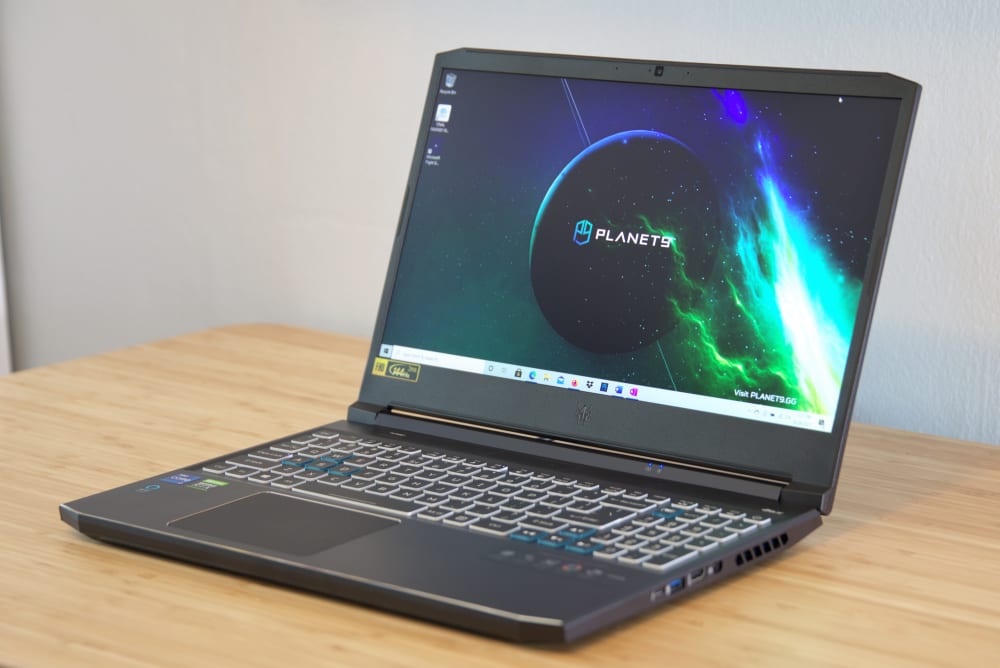Pros
-
Can handle modern games at 1080p
-
Strong processor performance
-
Extremely bright display
Cons
-
Lackluster keyboard
-
Short battery life
-
Too much bloatware
About the Acer Predator Helios 300 PH315-54-760S
Here are the specs of the laptop we tested:
- Processor: Intel Core i7-11800H
- Graphics: Nvidia GeForce RTX 3060 with 6GB RAM
- RAM: 16GB
- Storage: 512GB SSD
- Display: 1920 x 1080 144Hz IPS display
- Wireless connectivity: Wi-Fi 6, Bluetooth 5
- Wired connectivity: 3x USB-A, 1x USB-C, 1x HDMI 2.0, 1x Mini-DisplayPort 1x Ethernet, 1x 3.5mm audio
- Webcam: 720p
- Battery: 4-cell Lithium-Ion
- Weight: 5.51 pounds
- Size: 14.3 x 10.0 x 0.9 inches
The Helios 300’s key features are obvious: it has an eight-core processor from Intel’s latest 11th-gen Core product line and an Nvidia RTX 3060 graphics solution that can handle ray tracing. This combination has promise for both gamers and content creators. Acer also sells this laptop with configurations that include faster graphics hardware, such as the Nvidia RTX 3070, and a higher display resolution.
What we like
Game performance is solid for the price
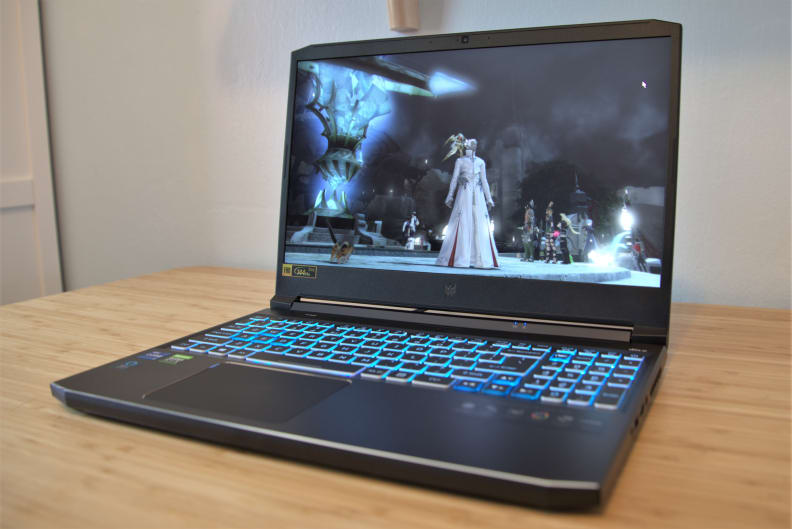
The Acer Predator Helios 300 we tested proved a good bet for 1080p gaming. It exceeded 60 frames per second in most games we tested and, in many cases, it beat that standard by a mile.
Our test configuration came with Nvidia’s RTX 3060 dedicated graphics packing 6GB of GDDR6 VRAM and up to 105 watts of power. The RTX 3060’s highest possible graphics power is 115 watts, so the Helios 300 is close to the RTX 3060’s performance ceiling.
The Nvidia RTX 3060 cranked out an average of 94 fps in Shadow of the Tomb Raider at a 1080p resolution and maximum graphics settings. It also averaged 85 fps in Total War: Warhammer II, again at 1080p and maximum graphics settings.
Control, the most demanding game in our test suite, pushed the laptop to its limits. The game averaged 38 fps at the same graphics settings and resolution with ray-tracing enabled on the High setting. It was playable, but not ideal. Gamers who crave top-tier ray-tracing performance will need to shop for a more expensive laptop.
Still, there’s no question the Acer Predator Helios 300 can handle modern games. The most demanding titles, like Control, will not hit 60 fps at their highest settings, but the vast majority of games aren’t as taxing. Gamers looking to play mainstream games like Grand Theft Auto V, Call of Duty, or Valorant will see smooth gameplay at the highest settings.
The processor is great for work and play
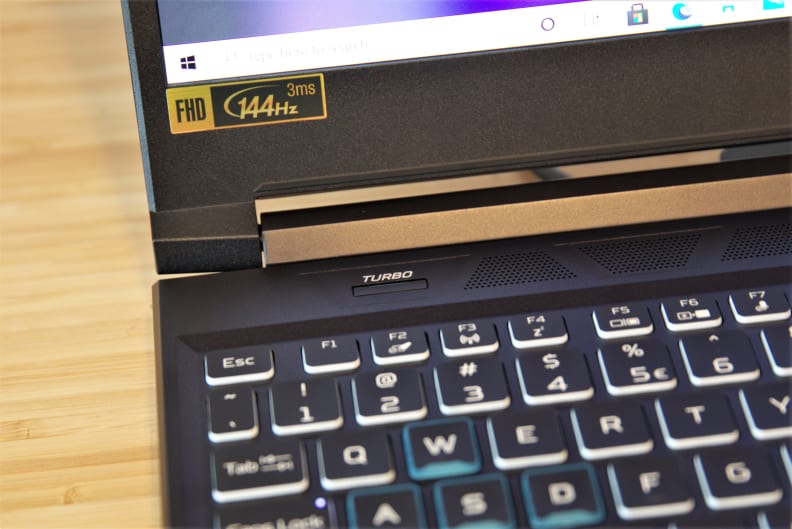
Intel’s new Core i7-11800H offers no surprises. It’s faster than prior 10th-gen hardware but neck-and-neck with its AMD competition. What impressed us most was not Intel’s performance but Acer’s pricing.
The processor’s architecture is not a significant change compared to 10th-gen Intel Core processors, but the Core i7-11800H is a performer. The Acer Predator Helios 300 cranked through Blender’s “Car Demo” processor benchmark in three minutes and 19 seconds. That’s identical to the Asus ROG Strix G15 and a second less than the Lenovo Legion 5 Pro Gen 6, both of which were tested with AMD Ryzen 5000-series processors. The Helios 300 is the least expensive of this trio, so it provides the best bang for your buck.
The Helios 300 hit a Geekbench 5 single-core score of 1513 and a multi-core score of 7971, which is faster than the same Asus and Lenovo laptops we mentioned above in terms of raw performance. The Lenovo Legion 5 Pro for instance, which we tested with an AMD Ryzen 7 5700H processor, scored slightly below the Acer. It hit 1472 in Geekbench 5 single-core and 7477 in Geekbench 5 multi-core. However, the AMD-powered Lenovo won in other benchmarks like Cinebench and the Basemark browser benchmark. In practical terms, this means the Helios 300 will perform some tasks faster, but unless you are timing how long they take you shouldn't notice a difference.
The figures from the Helios 300 are among the highest results we’ve seen from recent Intel laptops. Only MSI’s GE76 Raider, a more expensive laptop with a Core i9-11980H processor, scored better. It hit 1632 in Geekbench 5’s single-core test and 9118 in the multi-core test. The Helio 300’s results prove it’s a speedy gaming laptop, but also a solid budget workstation for content creators, developers, and digital artists.
More than enough ports
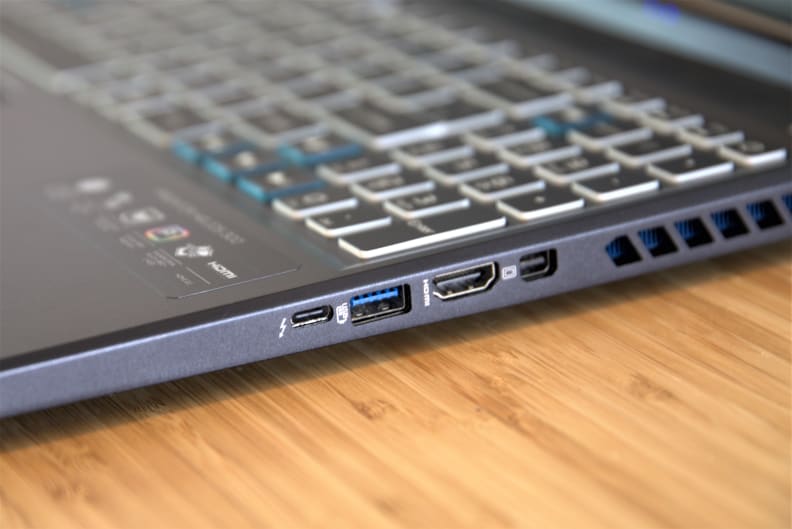
Acer’s Predator Helios 300 line is affordable, but that doesn’t mean it cuts back on connectivity. It’s packed with four USB ports, one of which is USB Type-C, plus HDMI, Mini DisplayPort, Ethernet, and an audio jack.
The ports are split between the laptop’s flanks. USB Type-A, Ethernet, and audio are on the left, while video and USB-C can be found on the right. We'd prefer if the ports were pushed further back, as their location could interfere with using peripherals like a mouse in some situations, but this is a minor issue.
Wireless connectivity is great, too. The laptop’s Intel Killer Wi-Fi 6 AX1650i wireless adapter supports Wi-Fi 6 and Bluetooth 5.0. The laptop’s Wi-Fi performance is great, reaching as high as 702 megabits per second when in the same room as a TP-Link Archer AX50 Wi-Fi 6 router. The laptop also managed over 200 Mbps from several rooms away. We felt no need to use the physical Ethernet port even when downloading several large games simultaneously.
The display is a great match for the hardware
Our Acer Helios 300 model has a 144Hz refresh rate display, which is a great choice for a mid-range gaming laptop. A 1080p resolution isn’t too taxing on the Nvidia RTX 3060 graphics hardware and the 144Hz refresh rate doesn’t overshoot its capabilities. Older, less demanding games are playable at a fluid 144 fps on this laptop, making maximum use of the 144Hz refresh rate.
This Acer’s display, unlike some past models we’ve reviewed, was incredibly bright. It reached a maximum of 425 nits, which is solid for a laptop in any class sold at any price and impressive for a mid-range gaming laptop. You won’t have trouble seeing the display in a bright room and it’s even usable outdoors.
Games look punchy and vibrant due to the high maximum brightness and complete coverage of the sRGB color gamut, but darker scenes can appear washed out because of the limited contrast ratio. Still, it’s a solid screen for a gaming laptop.
Acer does ship this laptop with several other options including a 1080p 360Hz display and a 1440p 165Hz display. We recommend avoiding the 360Hz display because its refresh rate is not a good match for the hardware’s performance. The 1440p 165Hz sounds promising but we weren’t able to test it.
What we don’t like
Acer’s design could use a refresh
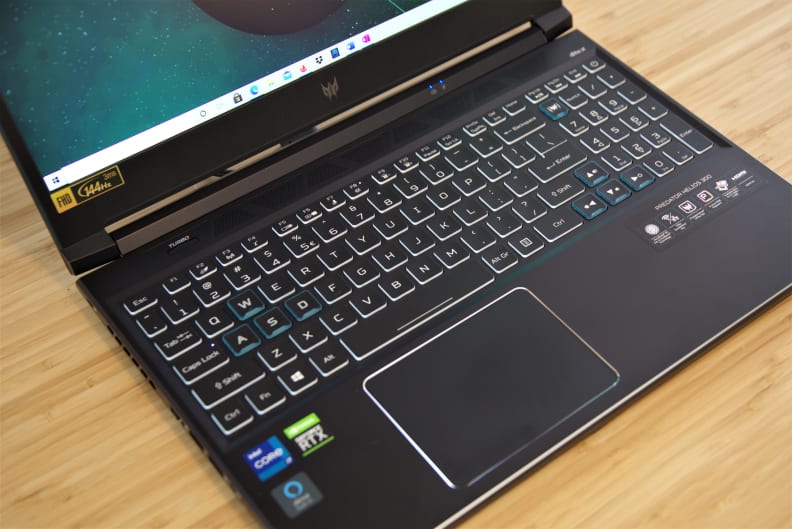
The Acer Predator Helios 300 provides excellent performance at a reasonable price, but this comes at the expense of the laptop’s overall look and feel. The Helios 300 isn’t cheap or flimsy, but it does seem out of date. Acer has used the same chassis for a couple of years and it could use a refresh. Lenovo’s Legion 5 Pro Gen 6, for example, has smaller display bezels that look more modern and reduce the laptop’s overall footprint.
A keyboard with a numpad spans the laptop’s interior. The layout is spacious, but the inclusion of a numpad shifts the keyboard to the left. I’m not a fan of this design choice because it forces your wrists to adopt an awkward angle. The keyboard is RGB backlit but colors can only be changed across four zones, not per key.
Key-feel is mushy and vague, offering little confidence when touch-typing at fast speeds. Keys also lack a responsive, crisp feel when rapidly tapping the same button. That can be annoying in fast-paced games that use only a few keys on the keyboard.
The Helios 300 lacks the subtle touches found on some competitors. Display bezels are thick on all sides, measuring three-eighths of an inch on each side and nearly an inch and a half along the bottom. We can overlook these flaws in Helios 300 configurations available at low prices, such as our test laptop, but Acer offers more expensive configurations that use the same chassis. This reduces the appeal of Helios 300 models that cost over $1,500.
Battery life isn’t great
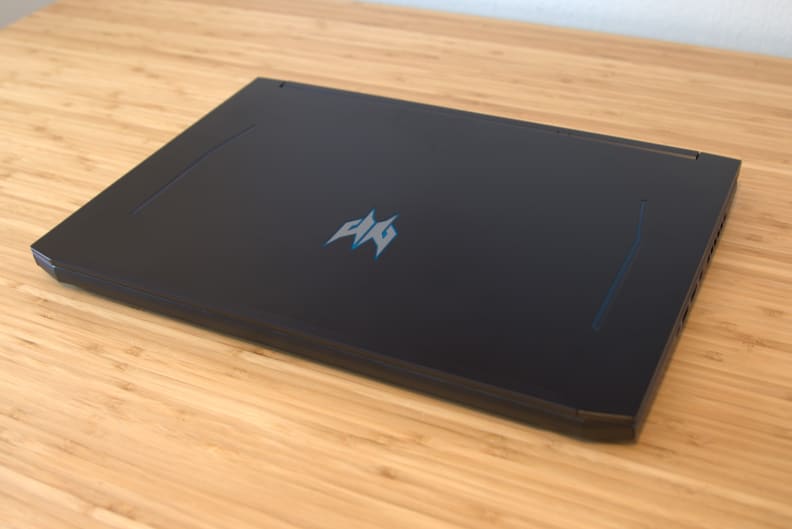
Our test configuration had a 59 watt-hour battery. This is not a large battery for a gaming laptop and it led to mediocre battery life in our tests. We recorded three hours and 46 minutes of endurance in our standard benchmark which loops a variety of websites to simulate typical web browsing.
Real-world use felt even less impressive. Just a couple of hours of light use could drain 70 to 80 percent of the battery. We suspect the bright display is to blame. Our benchmark calibrates the display to a brightness of 200 nits, but we preferred using it at around 75% of its maximum brightness, which is just north of 300 nits. A brighter display is more pleasant to use but drains the battery quickly.
While the Acer Predator Helios 300 doesn’t last long on a charge, its endurance is not unusual for a mid-range gaming laptop. Gamers craving more battery life will need to look at more expensive competition like the Razer Blade 15 Advanced or Asus ROG Strix G15. These alternatives ship with larger batteries that can squeeze out a couple of extra hours.
Too much bloatware
The company’s recent Predator Helios 300 models arrive with too much pre-installed software. Our test laptop had Norton Antivirus, Express VPN, Spotify, and an Acer-branded take on CyberLink’s video editing software, PowerDirector. It also hassled us with advertisements for “Acer exclusive” deals on games and software.
You will find one useful app installed: Acer PredatorSense. This is used to control performance mode, fan speed, and the laptop’s four RGB keyboard backlight zones. It’s a functional app that is easy to understand and looks attractive. But as far as the other apps go Acer needs to cool it with the bloatware.
Should you buy it?
Yes, the Acer Predator Helios 300 is an affordable desktop replacement
We’ve reviewed several configurations of the Acer Predator Helios 300 several times over the past two years. Our opinion of the laptop is heavily influenced by price. The Predator Helios 300’s keyboard, chunky design, and lackluster battery life don’t hold up in more expensive configurations. Fortunately for Acer, the configuration we tested for this review is not expensive. It retails at an MSRP of $1,199—rock-bottom pricing for a laptop with an Intel Core i7-11800H processor and Nvidia RTX 3060 graphics card. At that price, there are not many similarly-configured laptops in its class that can beat it.
The Acer Predator Helios 300 is great for gamers and content creators who want a laptop that will serve as a desktop alternative. Its pricing is low enough to remain competitive with desktops and there’s plenty of wired connectivity for adding a monitor and wired peripherals. The laptop’s chunky design and poor battery life hold back its portability, but that’s less of an issue if you rarely move it.
This underlines the strange state of PC gaming hardware in 2021: supply constraints have led to high prices and spotty availability. In a typical year, buying a laptop as a desktop alternative would mean paying a premium for lackluster performance. The Helios 300 shows that, in the strange year that is 2021, a chunky laptop might be the most practical choice.
Meet the tester
Matthew S. Smith is a veteran tech journalist and general-purpose PC hardware nerd. Formerly the Lead Editor of Reviews at Digital Trends, he has over a decade of experience covering PC hardware. Matt often flies the virtual skies in Microsoft Flight Simulator and is on a quest to grow the perfect heirloom tomato.
Checking our work.
Our team is here to help you buy the best stuff and love what you own. Our writers, editors, and experts obsess over the products we cover to make sure you're confident and satisfied. Have a different opinion about something we recommend? Email us and we'll compare notes.
Shoot us an email
